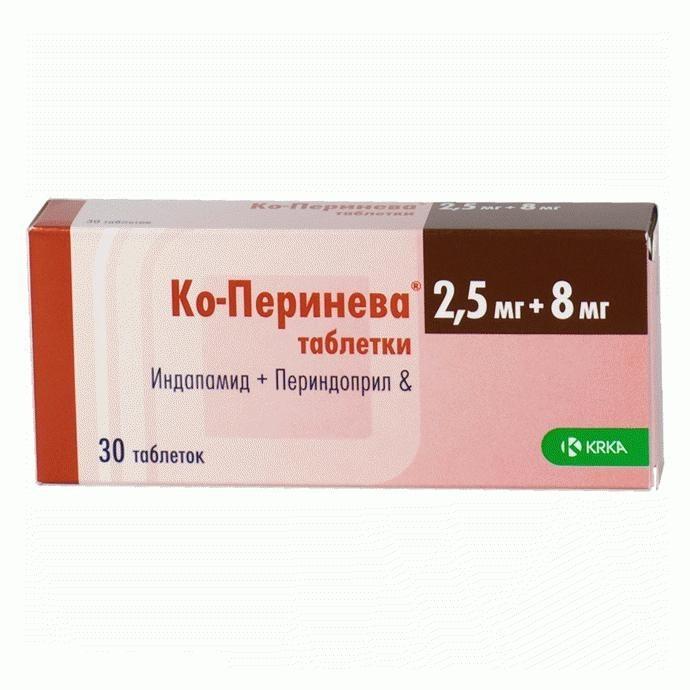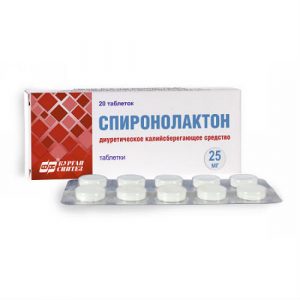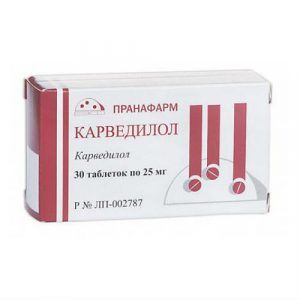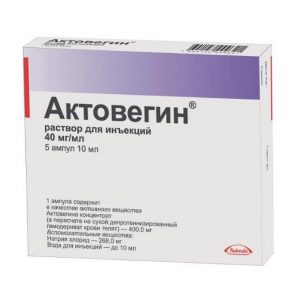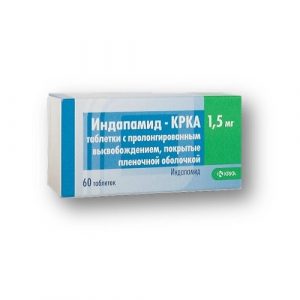Description
Release form
Tablets.
Packing
30 pcs.
Pharmacological action of
Ko-Perineva is a combined antihypertensive drug containing an ACE inhibitor – perindopril and a thiazide-like diuretic – indapamide. The drug has antihypertensive, diuretic and vasodilating effects. Ko-Perineva has a pronounced dose-dependent antihypertensive effect, which does not depend on the age and position of the patient s body and is not accompanied by reflex tachycardia. Does not affect lipid metabolism (total cholesterol, LDL, VLDL, HDL, triglycerides and carbohydrates), incl. in patients with diabetes. Reduces the risk of hypokalemia due to diuretic monotherapy. The antihypertensive effect persists for 24 hours. A stable decrease in blood pressure is achieved within 1 month on the background of the use of the drug Co-Perinev without an increase in heart rate. Discontinuation of treatment does not lead to the development of withdrawal syndrome.
Contraindications
history of angioedema (hereditary, idiopathic or angioneurotic edema due to ACE inhibitors)
severe renal failure (CC less than 30 ml / min)
azotemia
anuria
bilateral renal artery stenosis, single-artery stenosis
chronic heart disease hepatic insufficiency at stage lactase deficiency, glucose-galactose malabsorption
age up to 18 years (efficacy and safety have not been established)
severe liver failure (i.e. including encephalopathy)
pregnancy
lactation period
hypersensitivity to the components of Ko-Perinev.
Use during pregnancy and lactation
The use of the drug Ko-Perineva during pregnancy is contraindicated. Taking the drug during pregnancy can cause fetoplacental ischemia with a risk of slowing the development of the fetus. The use of the drug Co-Perinev during lactation is not recommended (indapamide is excreted in breast milk). If it is necessary to use the drug Co-Perinev during lactation, breastfeeding should be discontinued.
Special instructions
The simultaneous use of the drug Co-Perineva ® with lithium preparations is not recommended.
Co-Perinev ® therapy is contraindicated in patients with severe renal failure (CC less than 30 ml / min). In some patients with arterial hypertension without a previous renal impairment, therapy with Co-Perineva ® may cause symptoms of acute renal failure. In this case, treatment with Co-Perineva ® should be discontinued. In the future, you can resume combination therapy using low doses of Co-Perinev ®, or use perindopril and indapamide in monotherapy. Such patients need regular monitoring of serum potassium and creatinine levels every 2 weeks after the start of therapy and every subsequent 2 months of therapy with Co-Perineva ®.
Acute renal failure often develops in patients with severe chronic heart failure or an initial impaired renal function, including with bilateral renal artery stenosis or artery stenosis of the only functioning kidney. Co-Perineva ® is not recommended for patients with bilateral renal artery stenosis or artery stenosis of a single functioning kidney.
Hyponatremia is associated with a risk of a sudden decrease in blood pressure (especially in patients with bilateral renal artery stenosis or artery stenosis of a single functioning kidney). Therefore, when monitoring patients dynamically, attention should be paid to possible symptoms of dehydration and a decrease in the electrolyte content in blood plasma, for example, after prolonged diarrhea or vomiting. Such patients need regular monitoring of electrolytes in blood plasma. With a pronounced decrease in blood pressure, intravenous administration of 0.9% sodium chloride solution may be required.
Transient arterial hypotension is not a contraindication for further continuation of therapy. After the restoration of BCC and blood pressure, it is possible to resume therapy with Co-Perineva ®, using low doses of the drug, or using perindopril and indapamide in monotherapy.
The combined use of perindopril and indapamide does not prevent the development of hypokalemia, especially in patients with diabetes mellitus or renal failure. As in the case of the combined use of antihypertensive drugs and a diuretic, regular monitoring of potassium in the blood plasma is necessary.
It should be borne in mind that the excipients of the Co-Perineva ® preparation include lactose monohydrate, therefore the drug is contraindicated in patients with hereditary galactosemia, lactase deficiency, glucose-galactose malabsorption.
– Perindopril: Patients taking ACE inhibitors may develop neutropenia / agranulocytosis, thrombocytopenia, and anemia. In patients with normal renal function, in the absence of other complications, neutropenia develops rarely and disappears on its own after the withdrawal of ACE inhibitors.
Perindopril should be used with great caution in patients with connective tissue diseases and simultaneously receiving immunosuppressive therapy, allopurinol or procainamide, especially with existing renal impairment. Such patients may develop a severe infection that does not respond to intensive antibiotic therapy. In the case of the appointment of perindopril, it is recommended to periodically monitor the number of leukocytes in the blood. The patient should be warned that that in case of any signs of an infectious disease (sore throat, fever), you should immediately consult a doctor.
When taking ACE inhibitors, incl. perindopril, in rare cases, the development of angioedema of the face, lips, tongue, uvula of the upper palate, and / or larynx may be observed. When these symptoms appear, the drug should be stopped immediately. The condition of the patient should be monitored until the signs of edema disappear completely.
If angioneurotic edema affects only the face and lips, then its manifestations usually go away on their own or antihistamines can be used to treat symptoms. Angioneurotic edema, accompanied by swelling of the tongue or larynx, can lead to airway obstruction and death.
When symptoms of angioneurotic edema appear, immediately administer subcutaneous epinephrine (adrenaline) at a dilution of 1: 1000 (0.3 or 0.5 ml) and / or ensure airway obstruction.
In patients with a history of Quincke’s edema that is not associated with ACE inhibitors, the risk of its development when taking drugs of this group may be increased.
In rare cases, against the background of treatment with ACE inhibitors, angioedema of the intestine develops. Moreover, patients have abdominal pain as an isolated symptom or in combination with nausea and vomiting, in some cases without prior angioedema of the face and with a normal level of C-1 esterase. Diagnosis is by CT scan of the abdomen, ultrasound, or at the time of surgery. Symptoms disappear after stopping ACE inhibitors. In patients with abdominal pain receiving ACE inhibitors, a differential diagnosis must take into account the possibility of developing angioedema of the intestine.
There are some reports of the development of prolonged, life-threatening anaphylactoid reactions in patients receiving ACE inhibitors during desensitizing therapy with hymenoptera venom (bees, wasps). ACE inhibitors should be used with caution in patients prone to allergic reactions undergoing desensitization procedures. The administration of an ACE inhibitor should be avoided in patients receiving immunotherapy with hymenoptera venom. Nonetheless, the development of anaphylactoid reactions can be avoided by temporarily disabling the ACE inhibitor at least 24 hours before the start of the desensitization procedure.
In rare cases, in patients receiving ACE inhibitors, life-threatening anaphylactoid reactions may develop during LDL apheresis using dextran sulfate. To prevent an anaphylactoid reaction, ACE inhibitor therapy should be discontinued before each LDL apheresis procedure using high-flow membranes.
In patients receiving ACE inhibitors, anaphylactoid reactions have been observed during hemodialysis using high-flow membranes (e.g. AN69 ®). Therefore, it is desirable to use a membrane of a different type or to use a hypotensive drug of another pharmacotherapeutic group.
The combined use of perindopril and potassium-sparing diuretics, as well as potassium preparations and potassium-containing substitutes for edible salt is not recommended.
Dry cough may occur during therapy with an ACE inhibitor, which disappears after discontinuation of this group of drugs. When a dry cough appears, one should remember the possible connection of this symptom with the use of an ACE inhibitor. If the doctor considers that the patient needs ACE inhibitor therapy, Co-Perineva ® can be continued.
With cirrhosis of the liver, accompanied by edema and ascites, arterial hypotension, chronic heart failure, significant activation of RAAS is possible, especially with severe hypovolemia and a decrease in the electrolyte content in blood plasma (against the background of a salt-free diet or prolonged use of diuretics).
The use of an ACE inhibitor causes blockade of RAAS, therefore, a sharp decrease in blood pressure and / or an increase in serum creatinine is possible, indicating the development of acute renal failure, which is more often observed when taking the first dose of Co-Perinev ® or during the first 2 weeks of therapy .
In elderly patients, prior to taking Co-Perinev ®, renal function and plasma potassium should be evaluated. The initial dose of Co-Perineva ® is selected depending on the degree of blood pressure reduction, especially with a decrease in BCC and in chronic heart failure (IV functional class according to NYHA classification). Such measures can avoid a sharp decrease in blood pressure.
The risk of arterial hypotension exists in all patients however, special care should be taken when using the drug Co-Perineva ® in patients with coronary heart disease and cerebrovascular insufficiency. In such patients, treatment with the drug should begin with a dose of 2 mg / 625 mcg (initial dose).
In patients with diagnosed or suspected renal artery stenosis, treatment with Co-Perineva ® should begin in a hospital setting with a dose of 2 mg / 625 Ñg under the control of renal function and plasma potassium. Some patients may develop acute renal failure, which is reversible after discontinuation of the drug.
In patients with chronic heart failure (NYHA class IV functional class), treatment with Co-Perineva ® should be started with an initial dose of 2 mg / 625 mcg under medical supervision.
When prescribing Co-Perineva ® to patients with diabetes mellitus receiving hypoglycemic agents for oral administration or insulin, it is necessary to regularly monitor the concentration of glucose in the blood during the first month of therapy.
Perindopril (like other ACE inhibitors), has a less pronounced hypotensive effect in patients of the Negroid race compared with representatives of other races.
The use of ACE inhibitors in patients undergoing surgical intervention using general anesthesia can lead to a marked decrease in blood pressure, especially when using general anesthesia drugs that have a hypotensive effect.
It is recommended that you stop taking ACE inhibitors, including perindopril, 12 hours before surgery, warning the anesthetist about the use of ACE inhibitors.
ACE inhibitors should be used with caution in patients with left ventricular outflow obstruction and with aortic and / or mitral stenosis.
In rare cases, while taking ACE inhibitors, cholestatic jaundice occurs, with progression of which fulminant liver necrosis develops, sometimes with a fatal outcome. When jaundice or a significant increase in the activity of hepatic transaminases occurs while taking ACE inhibitors, Co-Perinev ® should be discontinued.
In patients after kidney transplantation or in patients on hemodialysis, anemia may develop.
During treatment with ACE inhibitors, incl. and perindopril may develop hyperkalemia. Risk factors for hyperkalemia are renal failure, old age, diabetes mellitus, some concomitant conditions (a decrease in BCC, acute heart failure in the decompensation stage, metabolic acidosis), the simultaneous use of potassium-sparing diuretics (such as spironolactone, eplerenone, triamteren, amiloride), as well as potassium preparations or potassium-containing substitutes for edible salt and the use of other drugs that increase plasma potassium (e.g., heparin). Hyperkalemia can lead to serious cardiac arrhythmias, sometimes fatal. The combined use of the above drugs must be carried out with caution.
– Indapamide: There are reports of cases of increased photosensitivity while taking thiazide and thiazide-like diuretics. If a photosensitivity reaction develops while taking Co-Perinev ®, treatment should be discontinued. If necessary, resume the use of Co-Perineva ®, protect exposed skin from direct exposure to sunlight and artificial ultraviolet rays.
Before starting treatment with Co-Perineva ®, it is necessary to determine the sodium content in blood plasma and, while taking the drug, conduct regular monitoring of electrolytes in blood plasma. All diuretics can cause hyponatremia, leading to serious complications.
Therapy with thiazide and thiazide-like diuretics is associated with the risk of hypokalemia (less than 3.4 mmol / l) in elderly patients, emaciated patients, patients with cirrhosis, patients with peripheral edema, ascites, coronary heart disease, and chronic heart failure. Hypokalemia in these patients enhances the toxic effect of cardiac glycosides and increases the risk of arrhythmias. An increased risk group includes patients with an extended QT interval on the ECG. Hypokalemia, like bradycardia, contributes to the development of severe cardiac arrhythmias, especially ventricular arrhythmias such as pirouette, which can be fatal. In all the cases described, regular monitoring of the potassium content in the blood plasma is necessary. The first determination of the potassium content in blood plasma must be carried out during the first week from the start of therapy with Co-Perineva ®.
Thiazide and thiazide-like diuretics reduce kidney excretion of calcium, leading to a slight and temporary increase in plasma calcium. Severe hypercalcemia may be due to latent hyperparathyroidism. Before examining the function of the parathyroid glands, you should stop taking the drug Co-Perineva ®.
Glucose concentration should be monitored in patients with diabetes mellitus.
In patients with an increased concentration of uric acid in blood plasma during therapy with Co-Perinev ®, an increase in the frequency of exacerbation of the course of gout is possible.
Hypovolemia as a result of a decrease in BCC or hyponatremia caused by diuretics at the beginning of treatment with Co-Perinev ® can lead to a decrease in glomerular filtration rate and be accompanied by an increase in plasma creatinine and urea.
Indapamide may give a false positive reaction during doping control.
Use in pediatrics
Co-Perineva ® is contraindicated in children and adolescents under 18 years of age due to a lack of data on the efficacy and safety of use.
Influence on the ability to drive vehicles and control mechanisms
Care must be taken when driving vehicles and other technical devices that require increased attention and speed of psychomotor reactions.
Composition of
in 1 tablet contains: perindopril erbumin 8 mg, indapamide 2.5 mg.
Dosage and administration
Assign inside 1 time / day, preferably in the morning before breakfast, drinking plenty of fluids. Doses are given for the ratio of perindopril / indapamide. The initial dose of Co-Perinev is 2 mg / 625 mg (1 tab.) 1 time / day. If after 1 month of taking the drug it is not possible to achieve adequate blood pressure control, then the dose should be increased to 4 mg / 1.25 mg (1 tab.) 1 time / day. For elderly patients, the initial dose of Co-Perinev is 2 mg / 625 mg (1 tab.) 1 time / day. Patients with renal failure (CC 60 ml / min or more) dose adjustment is not required. For patients with CC 30-60 ml / min, the maximum dose of Co-Perinev is 2 mg / 625 mg (1 tab.) 1 time / day. With CC less than 30 ml / min, the drug Co-Perineva is contraindicated. Patients with moderate hepatic impairment do not require dose adjustment.
Side effects
Classification of the incidence of side effects: very often -> 1/10 often – from> 1/100 to1 / 1000 to1 / 10000 to
From the hemopoietic system and lymphatic system: very rarely – hemorrhagic vasculitis, hemolytic anemia with long-term use in high doses – thrombocytopenia, leukopenia / neutropenia, agranulocytosis, aplastic anemia, which was recorded while taking ACE inhibitors (patients on hemodialysis or peritoneal dialysis).
From the central and peripheral nervous system: often – paresthesia, headache, dizziness, vertigo, asthenia infrequently – mood lability, sleep disturbances, increased sweating very rarely – confusion.
From the sensory organs: often – visual impairment, tinnitus.
From the cardiovascular system: often – a pronounced decrease in blood pressure, orthostatic hypotension is very rare – arrhythmias, incl. and bradycardia, ventricular tachycardia, atrial flutter, angina pectoris, myocardial infarction or stroke, possibly secondary, due to severe arterial hypotension in high-risk patients.
From the respiratory system: often – a dry, irritating, persistent cough that goes away after discontinuation of the drug, shortness of breath infrequently – bronchospasm is very rare – eosinophilic pneumonia, rhinitis.
From the digestive system: often – constipation, dry mucous membrane of the oral cavity, decreased appetite, nausea, epigastric pain, abdominal pain, taste change, vomiting, dyspepsia, diarrhea is very rare – pancreatitis, jaundice (cytolytic or cholestatic) frequency is not found: in case of liver failure, there is a possibility of developing hepatic encephalopathy, intestinal edema.
From the skin and subcutaneous fat: often – itching, maculopapular eruptions infrequently – angioedema of the face, oral mucosa, tongue, tongue of the upper palate and / or larynx, urticaria of an individual hypersensitivity reaction, mainly dermatological, in patients with an aggravated allergic history of purpura, a possible exacerbation of SLE is very rare – erythema multiforme, toxic epidermal necrolysis, Stevens-Johnson syndrome, isolated cases of photosensitivity reaction.
From the musculoskeletal system: often – muscle cramps.
From the urinary system: infrequently – renal failure very rarely – acute renal failure.
From the reproductive system and mammary glands: infrequently – impotence.
Laboratory indicators: hypokalemia, hyponatremia with hypovolemia, leading to a decrease in bcc and orthostatic hypotension, an increase in the concentration of uric acid and glucose in the blood serum, a slight increase in the concentration of creatinine and urea in the blood plasma, reversible after discontinuation of therapy, which often develops against the background of renal artery stenosis or artery stenosis of a single kidney, during treatment of hypertension with diuretics, in renal failure, a transient increase in plasma sodium hypochloria proteinuria is rarely hypercalcemia.
Drug Interactions
Concomitant use is not recommended
Lithium preparations. With the simultaneous use of lithium preparations and ACE inhibitors, cases of reversible increase in serum lithium concentration have been reported. The simultaneous use of thiazide diuretics can increase the concentration of lithium and the risk of its toxic effects while taking an ACE inhibitor.
Potassium-sparing diuretics (such as spironolactone, eplerenone, triamteren, amiloride), potassium preparations or potassium-containing substitutes for edible salt, as well as other drugs that increase the level of potassium in the blood plasma (for example, heparin).
Concomitant use requiring special care
Baclofen – potentiation of the hypotensive effect. Need to control blood pressure, kidney function and, if necessary, dose adjustment of antihypertensive drugs.
NSAIDs. The combination of ACE inhibitors with NSAIDs (non-selective COX inhibitors from the NSAID group, for example, acetisalicylic acid in doses, COX-2 inhibitors that have anti-inflammatory effects) – reduces the hypotensive effect of ACE inhibitors increases the risk of impaired renal function, up to the development of acute renal failure increases the serum potassium content in patients with pre-existing renal impairment.
This combination is recommended with caution, especially in elderly patients. Patients should receive a sufficient amount of fluid, as well as monitor renal function before and after the start of treatment with Co-Perinev.
Concomitant use requiring caution
Tricyclic antidepressants, antipsychotics (antipsychotics). They enhance the hypotensive effect and increase the risk of developing orthostatic hypotension (additive effect).
corticosteroids, tetracosactide. Reduction of hypotensive effect (fluid retention).
Other antihypertensive drugs: may enhance the antihypertensive effect of the drug Co-Perineva ®.
Perindopril
Concomitant use is not recommended
Potassium-sparing diuretics (spironolactone, triamteren, amiloride, eplerenone) and potassium preparations: when used together with ACE inhibitors, an increase in serum potassium content is possible up to a fatal outcome. If combined use of an ACE inhibitor and the above drugs is necessary (in the case of confirmed hypokalemia), caution should be exercised and regular monitoring of the potassium content in the blood plasma and ECG parameters should be carried out.
Concomitant use requiring special care
Hypoglycemic agents for oral administration (sulfonylurea derivatives) and insulin: the use of ACE inhibitors can enhance the hypoglycemic effect of hypoglycemic agents for oral administration and insulin in patients with diabetes mellitus with their combined use may increase glucose tolerance, which may require dose adjustment of hypoglycemic agents for oral and insulin administration.
Concomitant use with caution
Allopurinol, cytostatic immunosuppressants, corticosteroids (for systemic use) and procainamide: concomitant use of these drugs with ACE inhibitors may increase the risk of leukopenia.
General anesthesia drugs: ACE inhibitors may enhance the hypotensive effect of some general anesthesia drugs.
Diuretics (thiazide and loopback): the use of diuretics in high doses can lead to hypovolemia (due to a decrease in bcc), and the addition of perindopril to therapy – to a marked decrease in blood pressure.
Gold preparations: with the appointment of ACE inhibitors, incl. perindopril, in patients receiving a gold preparation (sodium aurothiomalate) iv, nitrate-like reactions (nausea, vomiting, marked decrease in blood pressure, facial skin hyperemia) were noted.
Indapamide
Concomitant use requiring special care
Drugs that cause pirouette arrhythmias: because of the risk of hypokalemia, indapamide should be used with caution in conjunction with drugs that cause pirouette arrhythmias, such as: antiarrhythmic drugs (quinidine, hydro , disopyramide, amiodarone, dofetilide, ibutilide, bretilium, sotalol) some antipsychotics: chlorpromazine, cyamemazine, levomepromazine, thioridazine, trifluoperazin benzamide (amisulpride, sulpride, sultopride, tiaprid), butyrophenones (droperidol, haloperidol), pimozide, other substances, such as: bepridil, cisapride, diphemanil methyl sulfate, erythromycin with iv use, halofantrine, misolastine, moxifloxacin, pentamidine, sparfloxacin vincam, vincam princincin, , astemizole, terfenadine. It is necessary to control the concentration of potassium in order to avoid hypokalemia, during the development of which it is necessary to carry out its correction, to control the QT interval on the ECG.
Medicines that can cause hypokalemia: amphotericin B for iv administration, gluco- and mineralocorticoids (for systemic use), laxatives that stimulate intestinal motility (laxatives that do not stimulate intestinal motility should be used), tetracosactides – increase the risk of hypokalemia (additive effect). It is necessary to control the concentration of potassium in the blood plasma, if necessary, its correction. Particular attention should be given to patients simultaneously receiving cardiac glycosides.
Cardiac glycosides: hypokalemia enhances the toxic effects of cardiac glycosides. With the simultaneous use of indapamide and cardiac glycosides, the potassium content in the blood plasma, ECG indicators should be monitored and, if necessary, the dose of cardiac glycosides should be adjusted.
Concomitant use, requiring caution
Metformin: renal failure may develop with diuretics. With simultaneous use with metformin, the risk of developing lactic acidosis increases. Metformin should not be used if the creatinine concentration in blood plasma exceeds 15 mg / l (135 μmol / l) in men and 12 mg / l (110 μmol / l) in women.
Iodine-containing contrast agents: a decrease in BCC with diuretics, an increased risk of developing acute renal failure, especially when using high doses of iodine-containing contrast agents. Before using iodine-containing contrast agents, it is necessary to compensate for bcc.
Calcium preparations: with simultaneous use, the development of hypercalcemia is possible due to a decrease in the excretion of calcium by the kidneys.
Cyclosporine: Increases the risk of developing impaired renal function (hypercreatininemia).
overdose
Symptoms: severe BP, nausea, vomiting, muscle cramps, dizziness, drowsiness, confusion, oliguria up to anuria (due to a decrease in BCC), water-electrolyte balance disturbances (low sodium and potassium in the blood plasma) are possible.
Treatment: gastric lavage and / or administration of activated charcoal, restoration of hydro-electrolyte balance in hospital. With a marked decrease in blood pressure, it is necessary to move the patient to a supine position with his legs raised upwards, then measures aimed at increasing BCC (introduction of 0.9% sodium chloride solution into / into) should be carried out. Perindoprilat, the active metabolite of perindopril, can be eliminated through dialysis.
Storage conditions
At a temperature not exceeding 30 ° C.
Shelf life
2 years.
Deystvuyushtee substance
Indapamide, perindopril
Conditions of release from
pharmacies Prescription
dosage form
tablets
of Ko-Perinev 2. 5mg + 8mg Tab. X30
Co-Perinev Indus + Perind. tab. 2.5mg + 8mg No. 30
Ko-Perineva tab 2.5mg + 8mg x 30
KRKA d.d. Novo mesto AO, Slovenia
